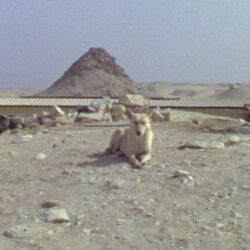C ADAGP Camille Henrot, A művész és a kamel mennour galéria (Parizs London) jóvoltából
Conceived as a play in several acts, the exhibition takes the viewer into worlds where the repetition of actions becomes a catalyst for therapeutic processes. The textile installation by Ouassila Arras (1993, France) transforms Trafó Gallery into a space of tenderness and softness despite its reference to scarred landscapes of Algeria. The carpet, being a second skin of the floor, is partly covered with henna and brushed for hours.
The video Earth (Parque Lage) by Maria Laet (1985, Brazil) is part of a series of artworks that, by performing simple gestures, demonstrate the impossible attempt of mending the disturbed tissue of the earth. The artist meticulously stitches the terrain – this deed is, however not meant to embellish the upper layer of the land, instead points to the limited and transitory effect of the struggles of an individual to restore what’s been left undone.
In her video piece Vumbi, Kapwani Kiwanga (1978, Canada) performs a ceaseless monotonous rite during the dry season in Tanzania on a tree covered in a layer of fine dust (vumbi in Swahili), which regains its true colors after repeated efforts. These careful wiping moves are on the one hand, pursuits of cleaning the trees – with the certainty in mind that they will soon be anyways covered with dirt -, on the other hand, the process can also be read as a gentle and painterly act of caressing the leaves from red to green again.
How shall we recalibrate our ties with the environment in the midst of destruction and collapse and forge new hopes? The works presented in the show offer ways of commencing this endeavour leading to sheer resilience in small, almost invisible and seemingly pointless moves instead of grand maneuvers and strategies.
The physical and mental work of remediation is what is expressed in Lida Abdul’s (1973, Afghanistan) video work What we saw upon awakening. In the video we see a group of men, carefully coordinating their moves that culminates in the tearing down of a house destroyed by a bombing in Kabul, resulting in a surreal vision of the deconstruction of a ruin. The video is a meditation on the aftermath of war, exposing the tangled aftershocks of destruction, acceptance and renewal.
Shot in Egypt, Camille Henrot’s (1978, France) Cynopolis turns our attention to the connections between a pack of stray dogs, a stream of tourists, workers on an archaeological excavation near Saqqara and the movement of a woman sorting trash on the outskirts of Cairo. The camera shifts from human to dog perspective and is at times completely inverted, destabilising the point of view.
By depicting fetishised monuments surrounded by plastic waste, Cynopolis raises questions of how we might manage cultural heritage and history while negotiating between the living and the dead, the animal and the human, the tourist and the local community and what kind of value we associate with these beings, sites and materials.
Andrea Éva Győri’s (1985, Hungary) sensual and subtle drawings are the imprints of processes of adapting to a new body-landscape, of healing it, mapping it, reclaiming it, and of taking back the control over it on a physical, mental and sensual level.
The exhibition creates space for seemingly senseless gestures and repetitive acts of doing and undoing, of mapping, mending, sorting, stitching, repairing and disentangling; attempts to come to terms with – inner or external – landscapes that are home to us, one move at a time.

